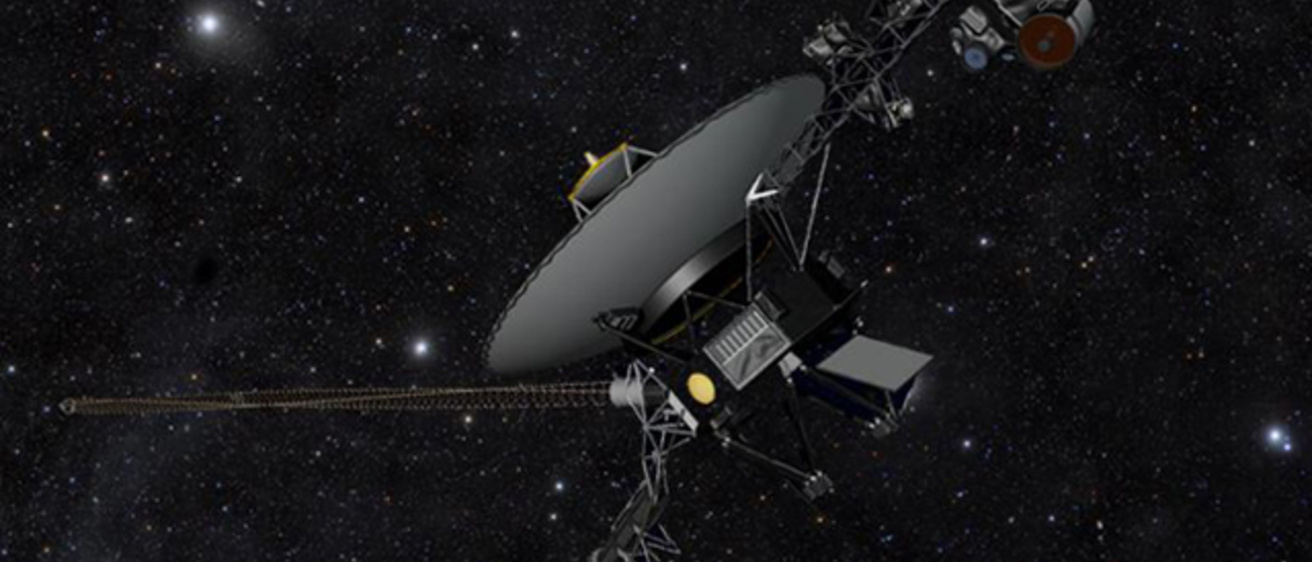The University of Iowa almost wasn’t included in a space mission that has turned out to be one of the longest in history.
UI Professor of Physics and Astronomy Don Gurnett’s instrument proposal for Voyager 1 initially wasn’t selected by NASA. But when the French-designed detector that was chosen ran into problems, NASA reached out to Gurnett, who offered to design and build a different instrument.
“It was a close call, you might say,” says Gurnett.
Forty years later, Gurnett’s radio- and plasma-wave instrument is still ticking aboard Voyager 1. It has gathered data that revolutionized knowledge of the solar system’s outer planets—first spied by Italian astronomer Galileo Galilei in 1610—and proved that Voyager 1 had left the solar system, flying farther than any other human-made object.

“I’m there at the instant of discovery, kind of like Galileo was. Of course, we’re not looking through a telescope; we’re looking through the eyes of Voyager,” Gurnett says.
Voyager 1 launched on Sept. 5, 1977, marking the first of two grand attempts (Voyager 1 and Voyager 2) to study Jupiter, Saturn, Uranus, and Neptune, the giant gaseous planets located furthest from the sun.
By modern standards, Voyager 1’s technology is outdated. The computers aboard it each have about 70 kilobytes of memory, less than that of a hand-held calculator. Data are stored on a special digital eight-track tape recorder. At its peak (flying by Jupiter), information was transmitted to Earth at 115,000 bits per second, compared to contemporary computers’ standard download speed of millions of bits per second; Voyager 1 has a 22-watt transmitter—roughly equal to the power generated from a refrigerator light bulb.
“It’s the first spacecraft I’ve had an instrument on that had a computer,” Gurnett says.
A particularly exciting moment captured by Gurnett’s instrument was the discovery of “whistlers” on Jupiter. On Earth, whistlers are created by lightning-generated radio waves. When the radio waves are converted to sound, they have a distinct whistling tone, from which the phenomenon gets its name. Gurnett and his team heard the same sounds as Voyager 1 flew by Jupiter on March 5, 1979. It was the first evidence of lightning occurring on another planet and was a bombshell finding early in the mission.
“The antennas are transmitting back these signals, and we hear these whistling tones, which we recognize right away as lightning-produced whistlers,” says Gurnett, who focused on Earth’s whistlers for his doctoral degree. “And, from our knowledge of Earth, those things are only produced by lightning. And so we concluded almost instantly that there’s lightning at Jupiter.”
Above all, Gurnett says he is most proud that his detector confirmed on Aug. 25, 2012, that Voyager 1 had left the solar system and entered interstellar space. It was a long time coming: Gurnett had predicted 20 years earlier the approximate boundary at which the sun’s influence, through solar wind, would cease. It took Voyager that much time to travel to the boundary (called the heliopause) and for Gurnett’s instrument to measure a shock wave from the sun.
The debate was settled. Voyager 1 had entered interstellar space, some 10.8 billion miles from the sun.
“Some people didn’t believe it,” Gurnett says of his hypothesis of the solar system’s boundary. “It was a prediction. No one really knew where the heliopause was. Nobody had a good way of measuring it. I did.”
An engineer at heart, Gurnett is proud that his instrument has survived the rigors of space, including the intense radiation fields extending millions of miles from planets that Voyager has flown by. The detector has benefited by being in a cocoon of sorts, he says. It operates at “just about room temperature,” bathed in warmth from the spacecraft’s radioactive power supply.
“One of the things that’s hard on electronics, I happen to know, is temperature changes,” Gurnett says. “So we have that going for us. We are in a very quiescent environment.”
Even traveling at the speed of light, it takes 19 hours for a signal to from Voyager 1 to reach Earth, and vice versa.
“If something goes wrong up there, it’s going to take us (a long time) to send a signal back for it to do something,” Gurnett says.
Forty years on, the 77-year-old Gurnett never imagined Voyager would still be gathering and transmitting information as it cruises among the stars.
“I mean, hey, how long does your TV last, to put it in simple terms like that?” he asks, chuckling. “Those things quit. With spacecraft, things fail.”
Yet Voyager sails on, and it’s now 13 billion miles from the sun. It still transmits information, the first data ever gathered about interstellar space. And, Gurnett’s radio- and plasma-wave detector remains front and center.
“There are still things we potentially can learn, if we can get far enough out,” he says.
